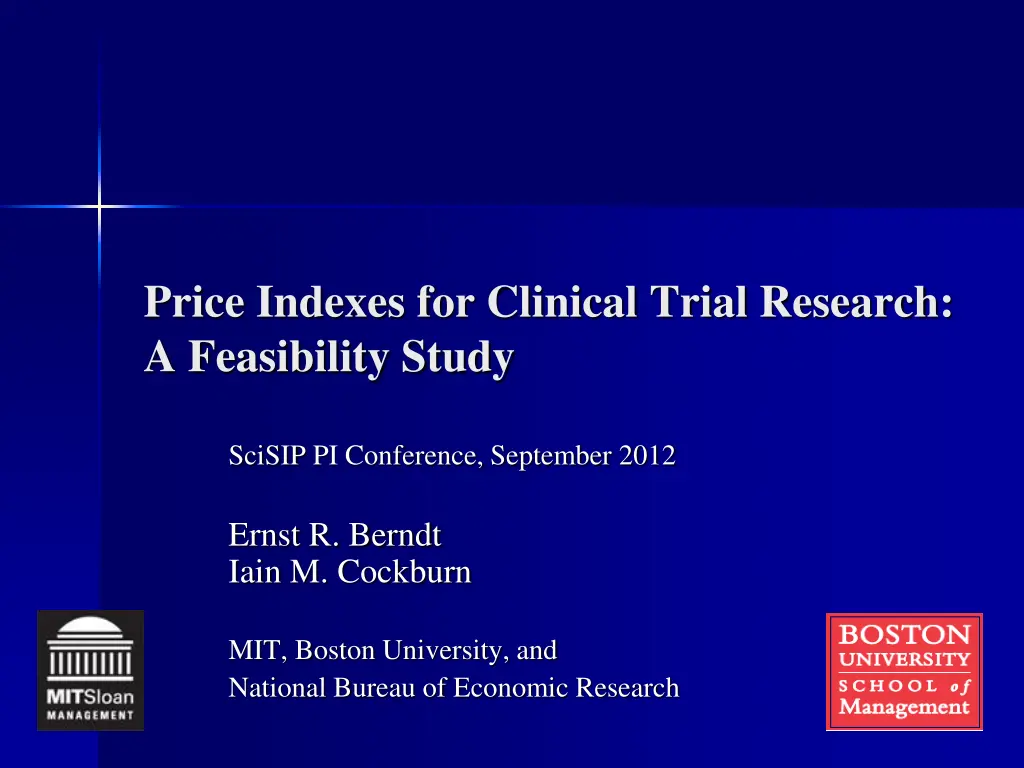
Clinical Trial Research: Cost Trends & Analysis
Explore a feasibility study on price indexes for clinical trials, analyzing cost trends and inflation rates in commercial trials between 1989-2009. Discover insights on investigator grants, differences in growth rates across therapeutic areas, phases of development, and more.
Download Presentation

Please find below an Image/Link to download the presentation.
The content on the website is provided AS IS for your information and personal use only. It may not be sold, licensed, or shared on other websites without obtaining consent from the author. If you encounter any issues during the download, it is possible that the publisher has removed the file from their server.
You are allowed to download the files provided on this website for personal or commercial use, subject to the condition that they are used lawfully. All files are the property of their respective owners.
The content on the website is provided AS IS for your information and personal use only. It may not be sold, licensed, or shared on other websites without obtaining consent from the author.
E N D
Presentation Transcript
Price Indexes for Clinical Trial Research: A Feasibility Study SciSIP PI Conference, September 2012 Ernst R. Berndt Iain M. Cockburn MIT, Boston University, and National Bureau of Economic Research
What? Analysis of trends in costs of doing clinical trials Focus on investigator grants payments to clinicians by trial sponsors Use hedonic price index methods to estimate the rate of inflation in commercial clinical trials during 1989-2009, controlling for trial characteristics Look at differences in growth rate of costs across Therapeutic areas Phases of clinical development Sites in US versus abroad Time and resource burden of protocols
Why? P vs. Q Hard to understand trends in research productivity (e.g. new drugs/$) without controlling properly for inflation in costs of doing research 40 $bn Worldwide R&D spending by PhRMA members 35 30 25 20 15 10 5 0 1964 1966 1968 1970 1972 1974 1976 1978 1980 1982 1984 1986 1988 1990 1992 1994 1996 1998 2000 2002 2004 Nominal R&D spending Constant 1964 dollars
Things we dont know What s driving up the cost of clinical development? Increases in real effort/decreasing marginal returns: more research resources needed to solve more difficult problems? E.g. longer duration trials, harder-to-measure endpoints, more difficult diseases, greater administrative burden Increases in unit costs i.e. the prices of resources used in research? Salaries, facilities, instrumentation, Public vs. private sector: NIH BRDPI index focuses on NIH-funded investigation
Data 225,000 records on investigator grants from MediData Solutions Inc. database Rich dataset derived from contracts between sponsors and investigators NB investigator grants are only 50% of total trial costs Coded for date, location, number of patients, therapeutic class, phase of development, and Site Work Effort
Key descriptive statistics Nominal mean total grant cost per patient grew 4X over 20 years 1989-2009 Compare to 2X growth in NIH BRDPI Site Work Effort grew 3X Sample composition: 10% Phase I+II / 70% Phase III swings to 30% Phase I+II / 50% Phase III Over time less cardiovascular, more CNS and oncology About 60% of sites are in US
Methodology As is done routinely for e.g. computers, estimate coefficients on year dummies Ztin a regression of log(Pit) = Xi + Zt+ it where Xiare trial and site characteristics (Phase, SWE, number of patients at site etc.) Back out constant quality price index from s
Key findings from work to date Large impact of SWE: 10% increase in SWE associated with 5% increase in costs Some evidence for economies of scale at the site level Controlling for the changing characteristics of trials and sites has a dramatic impact on measured inflation AAGR of cost-per-patient (8% p.a.) falls by 2/3 to 1/3 depending on subsetting of the data Constant-quality index rises at roughly the same rate as NIH BRPDI Inflation rate highest in late stage, ex-US trials with small numbers of patients per site Significantly higher in 2000-2009 vs 1989-1999
Conclusions A constant quality price index for private sector clinical research can be constructed from this type of data Increases in overall expenditure reflect both more trials being done, and substantial inflation in average unit costs in this activity Inflation in unit costs driven roughly 50% by increases in quality or effort and 50% by increases in prices of inputs e.g. wages, materials, instruments etc. Substantial effect of increases in SWE highlights the cost impact of using more complex and more difficult protocols
